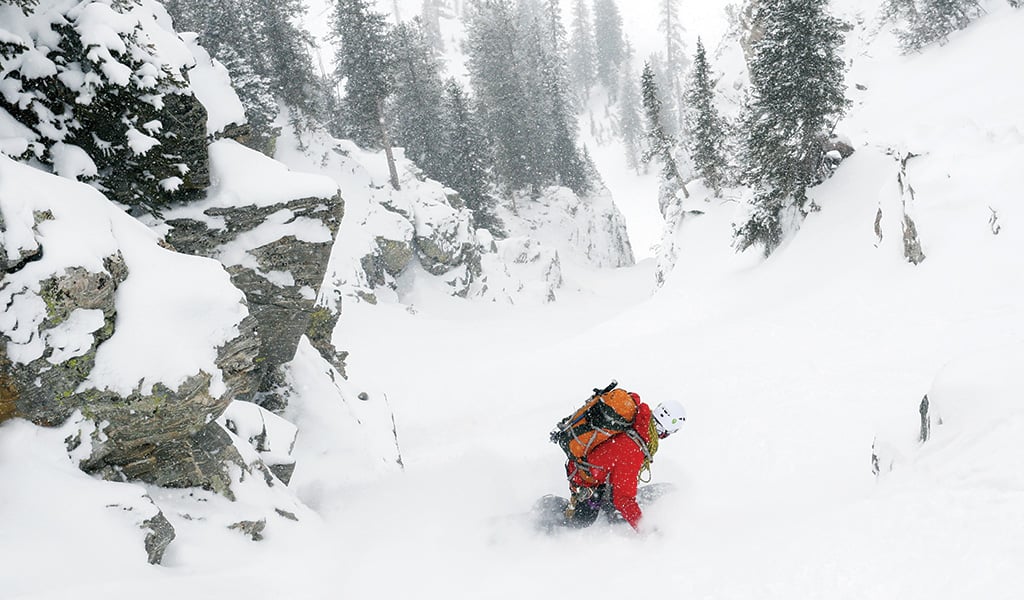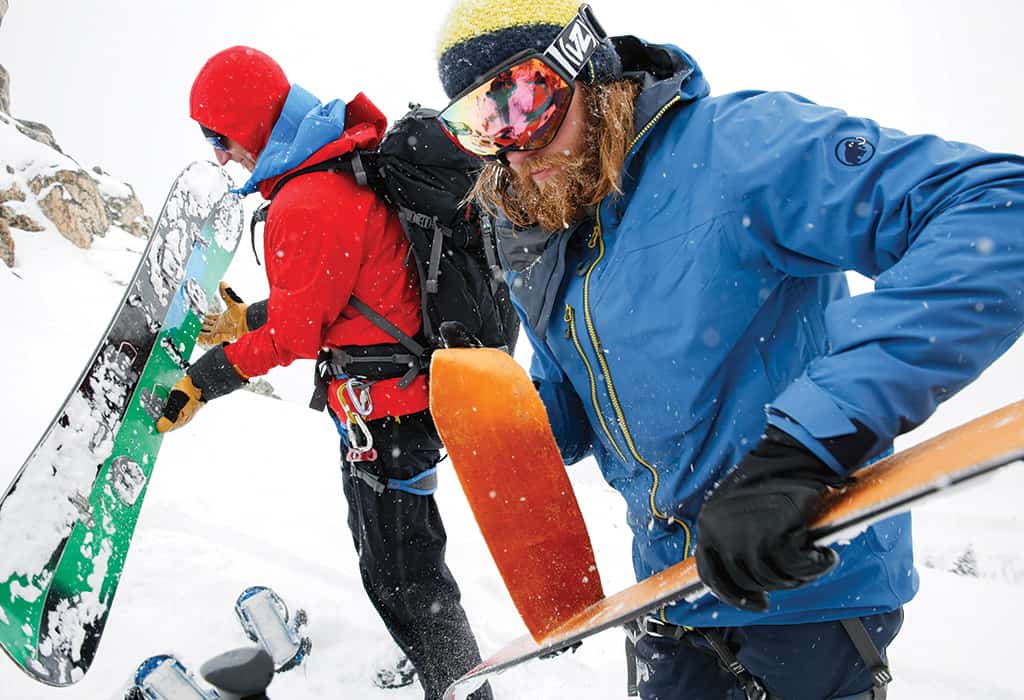Read The
Current Issue
Splitting Up
Sometimes it’s good for snowboards to break in half.

BY FREDERICK REIMERS
PHOTOGRAPHY BY David stubbs
AFTER FIFTEEN SEASONS guiding snowboard clients around the steeps of Valdez, Alaska, via helicopter—most everyone’s dream job—Jamie Weeks has reached a sort of saturation point. “On my days off, I’m finding myself in the calm and quiet of the backcountry under my own steam,” says the Wilson-based Weeks. “That’s what I want my clients to experience, too.”
Which is how Weeks finds himself in January 2015 showing a group of clients how to split their boards in half and walk uphill on them through No Name Basin just south of the boundaries of Jackson Hole Mountain Resort (JHMR). It’s a warm Friday during a dry spell, and soft snow is scarce at the resort, so there is a line of backcountry skiers herding up the famous Four Pines bootpack above them in search of untracked pockets. Weeks and his crew of eight (including coguide Nathanial Murphy) slap climbing skins on the bottom of the twinned boards and start gliding uphill in a loose line. As they zigzag up the steep slope, hikers struggle along the bootpack. “This is so much more casual,” says one of Weeks’ clients. Up top, they peel the skins, stash them in backpacks, fasten their boards back together with metal joiners, and make the long, cruisy descent. “It’s an elegant way to travel,” Weeks says. “Simple and free.”

WEEKS’ FOUR-DAY Backcountry Snowboarding Clinic, offered through Exum Mountain Guides, is aimed at advanced snowboarders looking to expand their skills to the backcountry. It’s an introduction to the gear—snowboards that split in half, bindings that convert to hinged walking platforms, and skins that adhere to the base of the planks to keep them from slipping backward while traveling uphill—as well as to strategies for efficient travel and staying safe in avalanche terrain. The course starts in the backcountry beside JHMR to take advantage of the lifts and then spends the next three days in the mountains near Teton Pass and in Grand Teton National Park, where skiers are abundant but where it’s still relatively rare to see snowboarders.
The reason for that: “Backcountry snowboard gear is just coming into its own,” Weeks says. “It’s a bit more complicated than backcountry ski gear, so that intimidates a lot of people. Once you get good with it, though, it’s just as fast and efficient in the backcountry as skiing.” Weeks starts his course at the resort because he wants to pack in as much practice on the gear as possible via multiple tram laps. “There’s no torsional rigidity when the board has been cut in half,” he says. “It rides differently. We want people to get used to that first thing.”

The uphill travel also takes a little getting used to. “I fell down on my first kick turn in No Name,” says Amy Golightly with a laugh. The Jackson local and her husband, Jeff, have dabbled in backcountry snowboarding but have been intimidated to head out with their skier friends. “Skiers approach the slopes differently than snowboarders do,” she says. “They pick different routes, which aren’t always suitable for snowboards, and can get impatient waiting for us to fiddle with the gear. It was nice to be able to practice the techniques in a supportive environment and to see the route choices through Jamie’s eyes.”
On the camp’s third day, Golightly isn’t holding anyone up. Instead, she’s charging out in front of the group as members march their way up the flanks of Grand Teton National Park’s popular 25 Short, so named because it tops out just 25 feet below an elevation of 10,000. It’s a warm, sunny day, and Weeks looks down the slope and spots client Sam Collins bringing up the rear. He’s tugging at his sweat-soaked shirt like he wants to take it off.
“Sam, you gotta leave at least one shirt on!” Weeks shouts. The two have known each other for years, with Weeks having guided him both at Jackson Hole and in Alaska. “I might be slow,” calls Collins, a retired banker from Brooklyn, New York, “but I’ll get there.”
The group spent a similarly warm day on Teton Pass the day before, wending their way up forested Mail Cabin Creek to the top of a popular powder stash called Windy Ridge. Before they dropped in, the group dug a pit in the snow to assess avalanche conditions and compared what they found to the daily reports from the local forecast center, all part of the process for backcountry skiers. Conditions were safe, and the group was rewarded for their efforts with a lap or two of surprisingly light, untracked power.
Today, though, on the east-facing aprons of 25 Short, Weeks hopes for a corn cycle. As the group slogs along, he’s got a trick up his sleeve to break up the three-hour ascent.

“THERE’S BEEN AN avalanche!” calls out Murphy, trundling down the hill from above. “Two of my buddies are buried. I need help!” There’s confusion amongst the group even though they realize their coleader snuck ahead to enact this scenario as a drill. How will they organize themselves to search for the “victims” (actually a pair of avalanche transceivers buried in backpacks under the snow by Murphy)? The crux is figuring out how to travel over the snow—do they click their boards back together, spending precious time, or sidle along awkwardly with their boards split in half? They all struggle a bit, which is the goal.
“It was a pretty eye-opening experience to realize how awkward it can be in an emergency,” Golightly says. “The best solution, obviously, is not to get into avalanches. That’s all about practicing good judgment.”
“Victims” located, the crew continues upwards, cresting a gradual ridge and arriving at the summit 2,000-some feet above the southern arm of Avalanche Canyon. The broken jaw of the Cathedral Group looms across the precipice. It’s a stunning view, and the group soaks it up as they relax, sitting on their packs, savoring the honest effort it took to get here. “This is why we do it,” Weeks says, “that and the powder waiting down below us.”

Nuts & Bolts
Exum’s 4-day Backcountry Snowboarding Clinic ($995, not including the Jackson Hole Mountain Resort lift ticket required for the first day) is February 5-8, 2016. From February 25-27, Exum offers a 3-day Snowboard Mountaineering Clinic ($795). The first day of this is at Snow King Resort. The last two days are in Grand Teton National Park. 307/733-2297, exumguides.com




